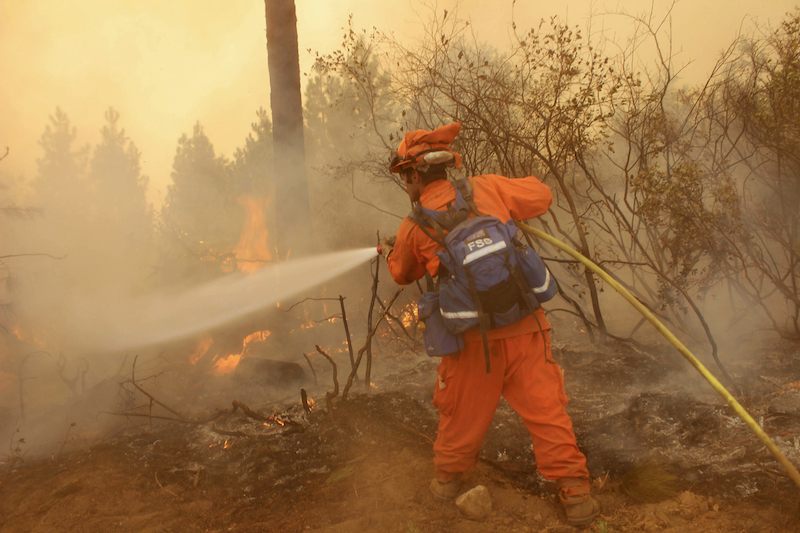Prisoners Fighting California Fires Make Less Than $2 an Hour
The state relies on thousands of incarcerated firefighters, some of whom are under 18, to help stop the blazes. An incarcerated man battles a fire at Stanislaus National Forest in California. (U.S. Forest Service / Mike McMillan)
An incarcerated man battles a fire at Stanislaus National Forest in California. (U.S. Forest Service / Mike McMillan)
The nearly 4,000 incarcerated workers who are trained to fight deadly fires across California often make less than $2 an hour and are not eligible to be hired as professional firefighters after they are released from prison. The work is physically strenuous and, in some cases, fatal. As forest fires ravage California, the state has become increasingly reliant on the program as a cost-saving measure.
In July, the California Department of Corrections and Rehabilitation tweeted that 2,000 incarcerated people, including 58 “youth offenders,” were working to fight fires. Bill Sessa, an information officer at the department, said that “all of the juvenile offenders [used to fight fires] have committed serious or violent felonies.” Adult incarcerated firefighters are often low-level, nonviolent offenders.
The incarcerated firefighters often carry out the grueling task of cutting firelines, using tools like chainsaws, axes and hoes to create a path of exposed soil to block fires.
The work is extremely dangerous. Shawna Lynn Jones, 22, died after she was injured fighting a fire in Malibu in 2016. A large stone fell about 100 feet and hit her head, knocking her unconscious. At the time of her death, she had less than two months left on her prison sentence.
According to The New York Times, incarcerated firefighters make $1 an hour while fighting a fire and up to $2.56 a day at the “conservation camps” where workers live. That is “lavish pay by prison standards,” Sessa said. Some program participants also are able to earn time off their prison sentences. The corrections department estimates that the conservation camps save state taxpayers about $100 million a year.
In 2014, lawyers for then-state Attorney General Kamala Harris argued that “extending 2-for-1 credits to all minimum custody inmates at this time would severely impact fire camp participation—a dangerous outcome while California is in the middle of a difficult fire season and severe drought.” Harris said she first read about the court filing in the newspaper and that she was “very troubled.”
Supporters of the program emphasize that participants voluntarily decide to become firefighters—some participants have explained that life outdoors at the conservation camps is more pleasant than the other option: an overcrowded prison cell.
“Jobs for prisoners can be a very positive thing, but given the vast power inequality between prisoners and their employers, there’s a real potential for exploitation and abuse,” said David Fathi, director of the American Civil Liberties Union National Prison Project. And due to their felon status, most former prison firefighters are excluded from professional firefighting opportunities.
‘‘The pay is ridiculous,’’ said La’Sonya Edwards, a 35-year-old incarcerated woman who makes a little more than $500 a year. ‘‘There are some days we are worn down to the core,’’ she said. ‘‘And this isn’t that different from slave conditions. We need to get paid more for what we do.’’
Your support matters…Independent journalism is under threat and overshadowed by heavily funded mainstream media.
You can help level the playing field. Become a member.
Your tax-deductible contribution keeps us digging beneath the headlines to give you thought-provoking, investigative reporting and analysis that unearths what's really happening- without compromise.
Give today to support our courageous, independent journalists.






You need to be a supporter to comment.
There are currently no responses to this article.
Be the first to respond.